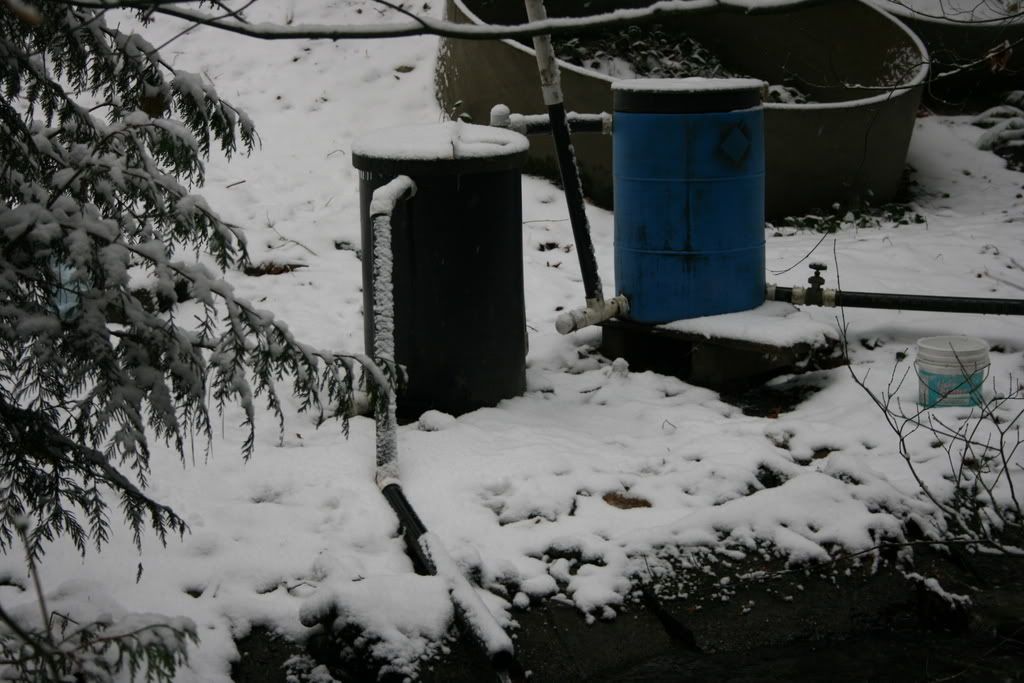Well, we sure went through a cold spell in the Puget Sound region between Christmas and New Years in 2008. We had snow on the ground and on the streets for most of that time. I was pretty worried about the incubator for a while there. After the first day or so of snow the scene down by the creek looked like this:

We ended up with quite a bit more snow than that, but that's one of the only pictures I took of the incubator in the snow this year.
Once the temp started to come up during this past week, all of the snow started to melt and the creek level rose quite a bit. It got high enough to cover the outlet tube of the incubator, which always worries me. Several years ago, we had some flooding in the creek and the water level was above the outlet tube. Unfortunately, at about the same time a good-sized tree branch floating down creek got wedged under the inlet pipe and lifted it up out of the water. By the time the creek level went down enough for me to notice the lack of outflow, all of the salmon in the incubator had died. I felt sick about that for about a week. That's why I get nervous whenever the outlet tube gets covered.
One difference now, though is we are using a much bigger inlet pipe. It is larger (6" vs 3", before), quite a bit heavier (and so more resistant to getting jacked up by a passing tree branch), and we have hammered a couple pieces of rebar into the creek bed and wired the end of the outlet tube down so it won't come up easily.
As I think I mentioned before, the flow rate in the incubator system should ideally be at least 10 gallons/minute. The flow has been considerable less than that lately, but with all of the stuff going on around here (we had 4 fairly large trees come down on the property due to snow. Luckily, none of them did any major property damage, though Francis & Abby's Odyssey minivan does have a dent in the hood that it didn't have before Christmas and the cap on Francis' pickup truck was destroyed when a large branch broke off a second-growth Douglas fir in the upper lot.) I had not had time to check the water line.
The day before yesterday, I spent the afternoon in the creek, starting at the upper end and working my way down to the incubator. First I made sure that there was plenty of water flowing into the inlet pipe (there was). Once that was assured, I started moving down creek and stopping at ever pipe junction. The pipe is 3" ABS plastic pipe, just like the stuff you'd use for a plumbing project in your house. It's mostly 10' lengths that are held together by collars. Those collars have two stainless steel screws on the upward facing side that hold everything together. The pipe is not completely air or water tight, so occasionally there are pockets of air trapped in the system. These pockets have to be bled out so that the pipe can carry as much water as possible. To bleed the system, all I have to do is go to each pipe junction and back one of the screws all the way out. If there is air trapped in that section, the pressure of the water forces it out. It's kinda cool to pull out one of the screws and hear it hissing away. It means things will be getting better in the system. Once all the air bleeds out, water will start to spurt out the hole. At that point you put the screw back in and move downstream to the next junction.
By the time I bled the whole system, a couple of hours had passed and I had improved the water flow significantly. Just from looking at it, I figured it was much more than the needed 10 gpm. To test it, I emptied all of the water from the clarifier and timed how long it took to refill. It's got about 55 gallons capacity and refilled in 3 minutes 20 seconds. That works out to just over 16 gallons per minute! (Imagine the voice of Marv Alpert, veteran broadcaster for the New Your Knicks) Yessss!
That was Tuesday. Since then the waterflow has continued to be strong.
While I was fooling around with the clarifier and incubator, I dropped the water level in the incubator to look at the first tray of eggs. I was very surprised to see that most of the eggs have not yet hatched. I expect that a few have, but the majority have not. Usually by the time they have spent 20 days in the incubator, most of them are hatched. Guess the cold water and air temps are retarding their growth. Nothing I can do about that, really. Just watch and see what happens.
As long as I keep water flowing, they will be fine.
I've done a bunch of reading and will chronicle some of that in the next post or two. I don't feel like writing any more this evening.
No comments:
Post a Comment